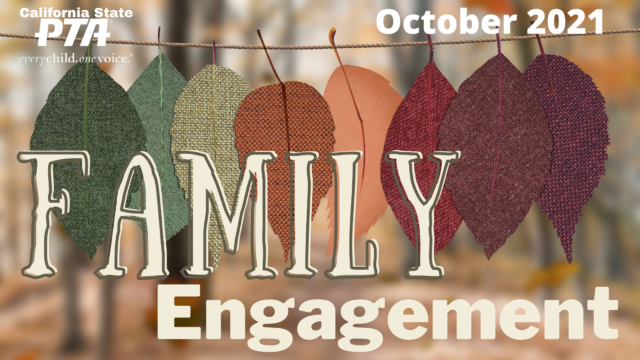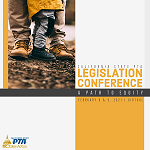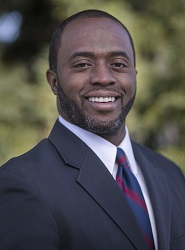By California State PTA Family Engagement and Communication Commission

What do focusing on equity, motivating and validating others, understanding learning goals, pivoting away from passive information, and bridging the digital divide have in common? All of them can strengthen family engagement and all were themes of the Family Engagement Summit I attended virtually last week.
It was wonderful to join family practitioners from throughout the country at the conference, even though the in-person event was held in the Eastern time zone, which made for some very early mornings!
There was so much good information that I want to share with all of you that I’m dividing it into two parts. This first blog post will cover the keynote speakers who were incredibly inspiring! Part two (coming soon) will cover the workshops I attended. Enjoy a little taste of this amazing conference!
Equity Occupies a Central Place in Family Engagement
The conference kicked off with an impassioned presentation by Principal Baruti Kafele. He is an equity expert, principal, author, and speaker who spoke to us about critical questions for effective family engagement. My favorite nugget from Principal Kafele was his 5 simple things our children of color need:
- Believe in me… without judging me or comparing me to my peers
- Get to know me… beyond who I am in the classroom
- Prove that you care about me… and therefore are committed to me
- Challenge me to maximize my potential… while taking the time to learn how I learn
- Expose me to my history… Because I need to know who I am
He also stressed that all children need to know that they are brilliant in order to help close the attitude gap between those students who have the will to achieve excellence and those who do not. We as PTA leaders need to keep these things in mind as we advocate for all children — equity is the job of everyone!
Motivation and Validation Make a Difference
Day two, we heard from Kim Bearden, award-winning teacher and co-founder of the Ron Clark Academy. She spoke about 6 Principles of Communication from her book Talk to Me: Find the right words to inspire, encourage, and get things done.
Two of those principles of communication are motivation and validation. We need to always keep our motivation in mind as we do this work. If we are not motivated by what is best for the kids, but we are motivated by our personal interests, we won’t come across the way we are hoping. The principle of validation makes sure that we see all people and not allow anyone to feel invisible. This is so important on school campuses — we have many families that don’t feel included or feel like what they say isn’t valued and this must change if we are going to have transformative family engagement.
Students and Families Need to Understand the “Why” Behind Learning
Christine Darden was our very inspiring opening to day three. She is a mathematician, data analyst, and aeronautical engineer who devoted much of her 40-year career in aerodynamics at NASA to researching supersonic flight and sonic booms. She worked at NASA after the time period covered in the film, Hidden Figures, but shared many of the same experiences and challenges.
While most of the math she shared with us went right over my head, her work as a math teacher left me with her greatest nugget: our students need to understand the why behind what they are learning. Oftentimes she heard, “I will never use this math, why do I need to learn this?” so she made it a point to give practical examples of how the math she taught can be used. This also applies to families — we need to understand the rationale behind what our children are learning so we can reinforce that at home.
School-to-Family Outreach Should be Active and Forward-Looking
The family engagement expert, Dr. Steve Constantino was a special keynote for virtual attendees. He has been working in the family engagement field for nearly thirty years. He has written several books including his recently updated Engage Every Family: Five Simple Principles which is used as a guide for schools who want to increase their family engagement.
My biggest takeaway from Constantino is that we need to move from a passive form of family engagement to an active one. In the passive model, we engage families by telling them about things that have already happened: parent teacher conferences, and other things that our children have done. In the active model, we help families understand what is about to happen in the classroom and how they can support it. This doesn’t have to look vastly different from what is happening now, we just need to pivot a bit. For example, instead of just sending home a folder full of old papers for a parent to sign, place a paper in that folder that states what is coming next (a lesson on weather), ask the parents to ask their child about it (tell me about the different types of weather), then have the parents write the child’s response and sign that. Or at family nights help families see the connections between the math or literacy games they are playing and their child’s curriculum.
If we can partner with schools to make these changes then we can move towards his idea of family engagement that says, “Every family, every teacher, every child, every day,” which is an amazing goal!
We Must Bridge the Digital Divide
Finally, we heard from Dr. Nicol Turner-Lee, a policy-maker working on the digital divide. She reminded us that prior to the pandemic we had the “digitally invisible” in our country. People from lower socioeconomic neighborhoods, people of color, and the elderly were not the focus of digital equity — but now they must be! Besides education, so many services now rely on a device and internet connectivity (social services, shopping, medical appointments, etc.) we must ensure that we leave no family off-line. Being connected is essential to life in our country.
In her upcoming book Dr. Turner-Lee also states that because education is the trajectory to social mobility, this is an equity issue. In our PTAs we can continue to work to help ensure that every child gets access to the technology and internet access that they need by facilitating partnerships with community groups and advocating in our communities to make this a reality.
Let’s All Put These Ideas into Action!
While I just scratched the surface of these amazing speakers, I hope you have found a nugget of something to take back to your PTA to begin working on. There is so much to learn in this area and so many great books on the topic. If you would like us to do a book club focusing on family engagement books, please email familyengagement@capta.org and if there is enough interest we will make it happen!
 California State PTA believes that all children deserve a quality education regardless of the community in which they live, the color of their skin, their language, their gender identity, or their immigration status.
California State PTA believes that all children deserve a quality education regardless of the community in which they live, the color of their skin, their language, their gender identity, or their immigration status. We all want all families to feel welcome at our schools.
We all want all families to feel welcome at our schools. “A Path to Equity” was the focus of this year’s Legislation Conference, which I attended as a local PTA leader and advocate, but also as the parent of two public high school students. Bringing equity to California public schools has long challenged our educational leaders, and the pandemic has highlighted vast inequities in the system and left millions of California students more disadvantaged than ever. From access to mental health care and meals to the widening of a vast digital divide, the conference underscored that the prospect of getting students back on track is daunting. Far from being pessimistic, however, the conference presented information and opportunities that we as parents and PTA advocates can use to disrupt ineffective old practices and bring public education into a new era in which all are included and empowered, and in which the needs of all are seen and addressed.
“A Path to Equity” was the focus of this year’s Legislation Conference, which I attended as a local PTA leader and advocate, but also as the parent of two public high school students. Bringing equity to California public schools has long challenged our educational leaders, and the pandemic has highlighted vast inequities in the system and left millions of California students more disadvantaged than ever. From access to mental health care and meals to the widening of a vast digital divide, the conference underscored that the prospect of getting students back on track is daunting. Far from being pessimistic, however, the conference presented information and opportunities that we as parents and PTA advocates can use to disrupt ineffective old practices and bring public education into a new era in which all are included and empowered, and in which the needs of all are seen and addressed. State Superintendent Tony Thurmond opened the conference and focused on restorative justice and increased digital access and literacy as examples of measures needed at the state level to increase inclusiveness and access for all students. President Celia Jaffe shared CAPTA’s ten recommendations for the timely and safe reopening of schools. Director of Legislation Shereen Walter shared CAPTA’s legislative agenda and the critical need for “our collective voices to influence legislation and the state budget to improve equity, access, and opportunity for all of California’s children.” Then, National PTA President-Elect Anna King shared her personal stories of witnessing how racial and economic inequities affected her own children, injustices which led directly to her involvement in PTA and her work to bring a collective voice on behalf of all children to our nation’s leaders and educational decision-makers. This was a powerful start to the conference.
State Superintendent Tony Thurmond opened the conference and focused on restorative justice and increased digital access and literacy as examples of measures needed at the state level to increase inclusiveness and access for all students. President Celia Jaffe shared CAPTA’s ten recommendations for the timely and safe reopening of schools. Director of Legislation Shereen Walter shared CAPTA’s legislative agenda and the critical need for “our collective voices to influence legislation and the state budget to improve equity, access, and opportunity for all of California’s children.” Then, National PTA President-Elect Anna King shared her personal stories of witnessing how racial and economic inequities affected her own children, injustices which led directly to her involvement in PTA and her work to bring a collective voice on behalf of all children to our nation’s leaders and educational decision-makers. This was a powerful start to the conference.